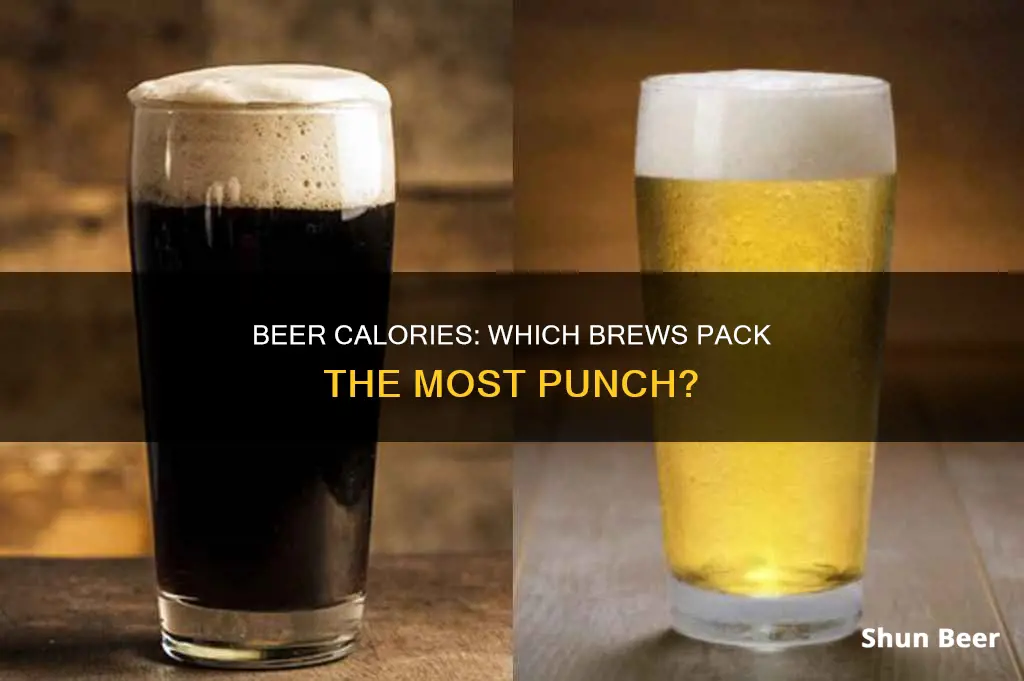
Beer is a popular drink worldwide, but it's important to be aware of its calorie content, especially when monitoring your weight. The calorie count in beer varies, but it's generally influenced by two key factors: alcohol content and carbohydrates. Beers with higher alcohol levels and added sugars tend to have more calories. On average, a classic beer with 5% alcohol content has approximately 43 kilocalories per 100ml, but this can range from 60 to 300 calories per 12 ounces. When comparing beer to other alcoholic drinks, it typically falls somewhere in the middle in terms of calorie count.
What You'll Learn
- Calories in beer are mainly made up of carbs and alcohol
- Beers with high alcohol content tend to have more calories
- Beer is one of the alcoholic drinks with the least calories
- A classic beer with an average alcohol content of 5% has about 43 kilocalories for 100ml
- Drinking lots of beer will make you gain weight, including belly fat

Calories in beer are mainly made up of carbs and alcohol
The calorie content of beer depends mostly on its alcohol content and, to a lesser extent, its carbohydrate content. Brewers make beer by fermenting grains such as barley and wheat, which naturally contain carbohydrates. Beer may also contain added sugars, further increasing its carbohydrate levels.
The number of carbohydrates in beer varies according to the fermentation process and the ingredients used. For example, a 12-ounce serving of Bud Light contains 6.6 grams of carbohydrates, while Budweiser, a heavier beer, contains 10.6 grams of carbohydrates.
Light beers tend to be lower in calories and carbohydrates than full-flavored beers. For instance, Miller 64, a very low-alcohol beer, contains around 60 calories in a 12-ounce serving, while most light beers with 4% alcohol contain about 100 calories. Bud Light Next is another low-calorie option, containing 80 calories and zero carbohydrates.
On the other hand, heavy hitters like regular IPAs, double or imperial IPAs, and Belgian-style Trippels can pack 200 to 300 calories in a 12-ounce serving. However, a lower-alcohol "session" IPA can cut that down to about 140 calories.
When it comes to calories, beer and wine also differ. A 5% ABV pint of beer contains approximately 239 calories, while a 12% ABV 175ml glass of wine contains about 133 calories. This difference can be attributed to the leftover carbohydrates found in beer, as wine typically has a lower sugar content.
Calories in Innis & Gunn Beer: Nutritional Breakdown
You may want to see also

Beers with high alcohol content tend to have more calories
The calorie content of beer depends on various factors, including alcohol content, carbohydrates, and added sugar. Beers with high alcohol content tend to have more calories. For instance, a typical 12 oz beer with 5% alcohol content has around 140-150 calories, while an average IPA with 7-11% alcohol content can have 200-300 calories. The calorie content can vary widely depending on the alcohol percentage, with some high-alcohol beers containing twice as many calories as low-alcohol options.
The amount of alcohol in a beer is the primary determinant of its calorie count. Higher alcohol content leads to more calories, and beers with added sugar also have extra calories. Alcohol itself contains calories, with 7 calories per gram. Therefore, beers with higher alcohol content will generally have a higher calorie count.
The type of beer also plays a role in its calorie content. Craft, seasonal, and dark beers, such as stouts, tend to have more calories than lighter options. Additionally, the presence of carbohydrates in beer contributes to its calorie count. Beer is made from fermented grain, and the carbohydrates in the grain can remain in the final product, adding to the calorie count.
It is important to note that the effect of beer consumption on weight gain is complex. While beer can contribute to weight gain, especially when consumed in excess, moderate drinking is generally considered acceptable. Moderate drinking is defined as one beer or less per day for women and two beers or less per day for men. Additionally, non-alcoholic beers are available, which typically have a lower calorie content.
Calories in Pub Beer: What's the Count?
You may want to see also

Beer is one of the alcoholic drinks with the least calories
Beers with higher alcohol content will tend to have more calories. A heavy-hitting IPA with 7% to 11% ABV can have 200 to 300 calories. The calorie content also depends on the amount of leftover carbohydrates and sugar in the beer. A beer with added sugar will have extra calories.
Compared to other alcoholic drinks, beer is a good choice if you want to watch your weight. For example, a regular beer has 43kcal per 100ml, while absinthe has 348kcal per 100ml. However, drinking several bottles of beer will mean a shot of absinthe has fewer calories overall. Other drinks with fewer calories than beer include cider, prosecco, wine, champagne, and sangria.
If you are watching your calorie intake, opt for non-alcoholic beers, which usually contain fewer calories. You can also try drinking a glass of water between each alcoholic drink and using a pre-measured cup to keep an eye on portion sizes.
Cider Beers: Which Have the Least Calories?
You may want to see also

A classic beer with an average alcohol content of 5% has about 43 kilocalories for 100ml
The calorie content of beer varies depending on its alcohol and carbohydrate content. Generally, craft, seasonal, and high alcohol content beers will have more calories than lighter beers. For example, a beer with 7-11% alcohol content, such as a regular IPA, double or imperial IPA, or a Belgian-style Tripel, can contain 200 to 300 calories. On the other hand, very low alcohol beers (2-3% alcohol) like Miller 64 start at around 60 calories for a 12 oz serving.
The amount of beer you consume and how often you consume it will also impact your overall calorie intake. It is recommended that men drink two alcoholic beverages or fewer per day, while women should stick to one alcoholic beverage or fewer per day. This will help protect your liver and heart. If you are concerned about your calorie intake, you can opt for non-alcoholic beers, which usually contain fewer calories, or drink a glass of water between each alcoholic beverage to moderate your intake.
Calorie Count for Blue Moon's Peach Beer
You may want to see also

Drinking lots of beer will make you gain weight, including belly fat
Drinking beer is often associated with weight gain, particularly around the belly, also known as a "beer belly". While beer is not the sole cause of weight gain, consuming too many calories can lead to an increase in body fat. Beer contains as many calories as a soft drink, with a typical beer containing around 140-150 calories. If you drink several beers in one sitting, you can experience a serious calorie overload.
Beer is an alcoholic drink made from grains such as barley, wheat, or rye, and flavoured with hops, fruits, herbs, or spices. The strength of a beer depends on its alcohol content, which is measured as alcohol by volume (ABV). The alcohol content of beer typically ranges from 4% to 6%, but can vary from 0.5% to 40%. The calorie content of beer depends on its strength—the more alcohol it contains, the more calories it has. This is because alcohol contains seven calories per gram, higher than carbs and protein (four calories per gram) but lower than fat (nine calories per gram).
In addition to the calories in beer, drinking alcohol can also increase your appetite and prevent your body from burning fat. Alcohol interferes with your body's ability to burn fat because your body prioritizes the breakdown of alcohol over other sources of fuel, including stored fat. This means that regular drinking, especially in large quantities, can contribute to an increase in body fat.
Furthermore, the flowers of the hop plant, which are used to flavour beer, are known to be high in phytoestrogens. Phytoestrogens are plant compounds that can mimic the action of the female sex hormone estrogen in the body. It has been suggested that the hops in beer might cause hormonal changes in men that increase the risk of storing belly fat. However, the effects of phytoestrogens on weight and belly fat are still unknown.
While the relationship between alcohol consumption and weight gain is complex and varies across individuals, drinking large amounts of beer has been linked to an increased risk of weight gain and belly fat. To minimize the risk of weight gain, it is recommended to keep alcohol intake within recommended limits and lead a healthy, active lifestyle.
Calories in Beer vs. Wine: Which Has More?
You may want to see also
Frequently asked questions
The calorie content of beer is influenced by its alcohol content, with stronger beers generally containing more calories. The presence of carbohydrates and sugar can also increase the calorie count.
Craft beers, seasonal beers, and beers with high alcohol content tend to have more calories. Specific examples include Snake Venom, the beer with the highest calorie count in the world, with 2050 calories per bottle, and Tokyo by Brewdog brewery, with 546 calories per bottle.
Yes, non-alcoholic beers tend to have fewer calories. Some other low-calorie options include Bud Light Next (80 calories) and Dogfish Head Slightly Mighty (around 100 calories).







